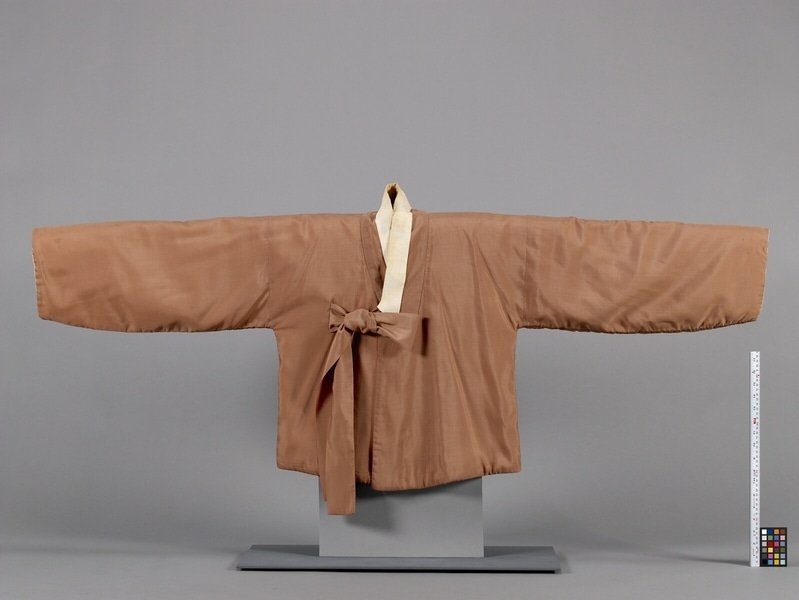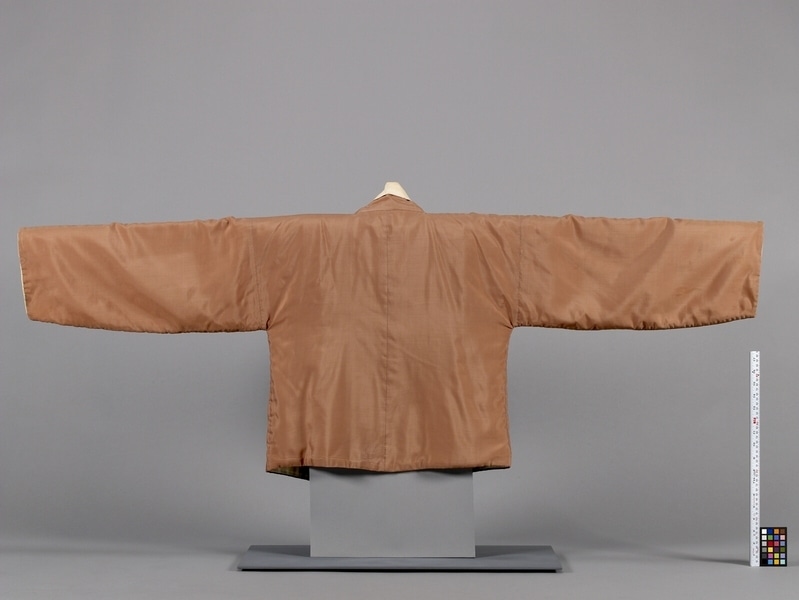Jacket Item Number: Ed1.312 from the MOA: University of British Columbia


Description
Light brown man’s jacket. The centre opening has front panels that overlap to the right when tied closed with two long thick ties. The outer facings of the v-neck are rounded at the lower edge. The neck is finished with a white collar or facing with crumpled paper inside. The long wide sleeves curve upwards at the wrists. The light brown ties are sewn at the ends of the outer facing and cut with pinking shears creating a zigzag edge. A thinner brown tie is attached to the right inner facing with a corresponding tie on the left underarm seam. There is a centre back seam. The inside lining is unbleached cotton.
History Of Use
Men’s jackets “Jo-go-ri” had changed little from those of the Chosun Dynasty by the 1950s. Only the fabric was different, with rayon being substituted for silk. Such “Jo-go-ri” were part of sets of men’s formal wear. Lined “Jo-go-ri” filled with felt or other materials were worn in autumn and winter. The ribbon ties on men’s “Jo-go-ri” are shorter and wider than those used by women, as are the white collar and facings.
Specific Techniques
The garment is machine-sewn except for the white collar, which is attached with invisible hand sewing.
Narrative
Most of the clothing in the J. McRee Elrod Collection was made for him and his family by friends while they were living in Korea, much of it by Kim, Sung Sook. She and her family lived cooperatively in the same house as the Elrod family. While they were there, the Elrods preferred to wear Korean clothing on very cold days and for social occasions. They found it to be more comfortable than western clothing in cold weather, as public buildings were unheated in the period immediately following the Korean War. It also was more comfortable for floor seating in Korean homes, and easier to store with limited furniture than western clothing.
Item History
- Made by Sung Sook Kim (Maker) in Seoul, Korea between 1955 and 1960
- Collected between 1955 and 1960
- Owned by J. McRee Elrod before October 13, 1976
- Received from J. McRee Elrod (Donor) on October 13, 1976
What
- Name
- Jacket
- Identification Number
- Ed1.312
- Type of Item
- jacket
- Material
- rayon fibre, wool fibre ?, dye, cotton fibre and paper
- Manufacturing Technique
- spun, woven, dyed, cut, sewn and pasted
- Overall
- height 65.0 cm, width 160.5 cm
Who
- Culture
- Korean
- Creator
- Sung Sook Kim (Maker)
- Previous Owner
- J. McRee Elrod
- Received from
- J. McRee Elrod (Donor)
Where
- Holding Institution
- MOA: University of British Columbia
- Made in
- Seoul, Korea
When
- Creation Date
- between 1955 and 1960
- Collection Date
- between 1955 and 1960
- Ownership Date
- before October 13, 1976
- Acquisition Date
- on October 13, 1976
Other
- Item Classes
- textiles
- Condition
- good
- Accession Number
- 0335/0002 e